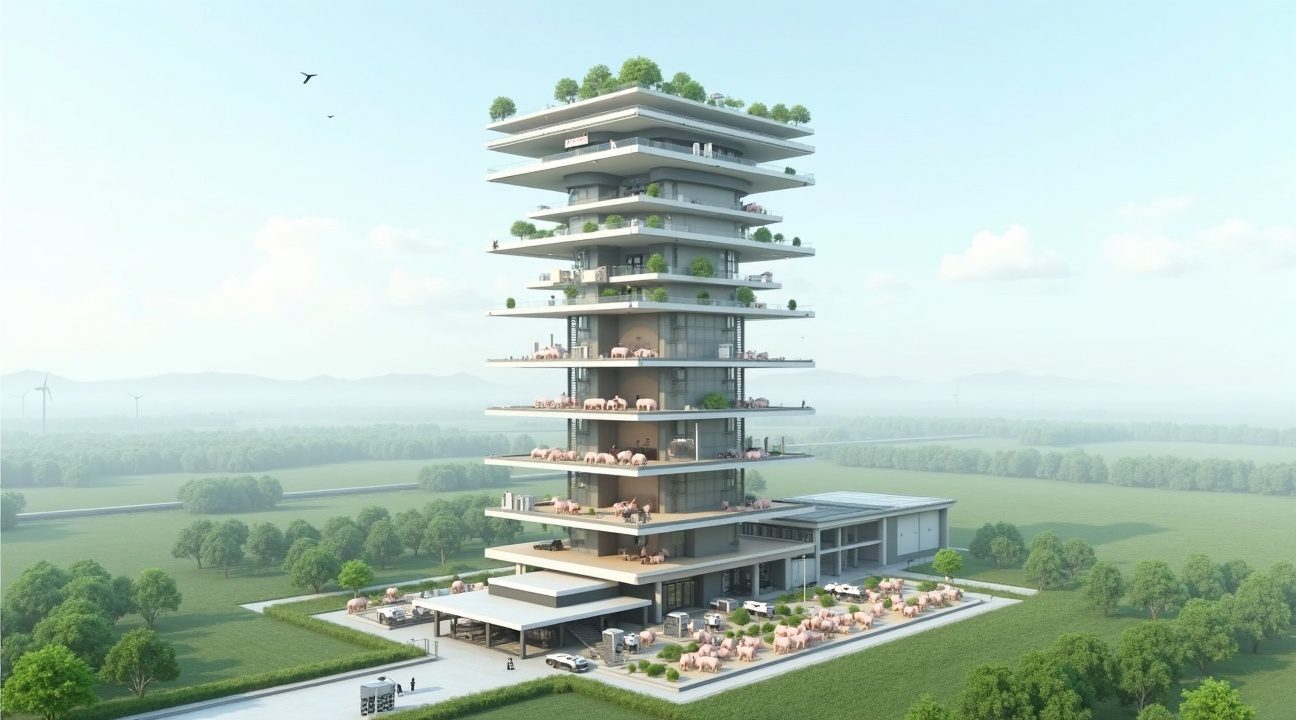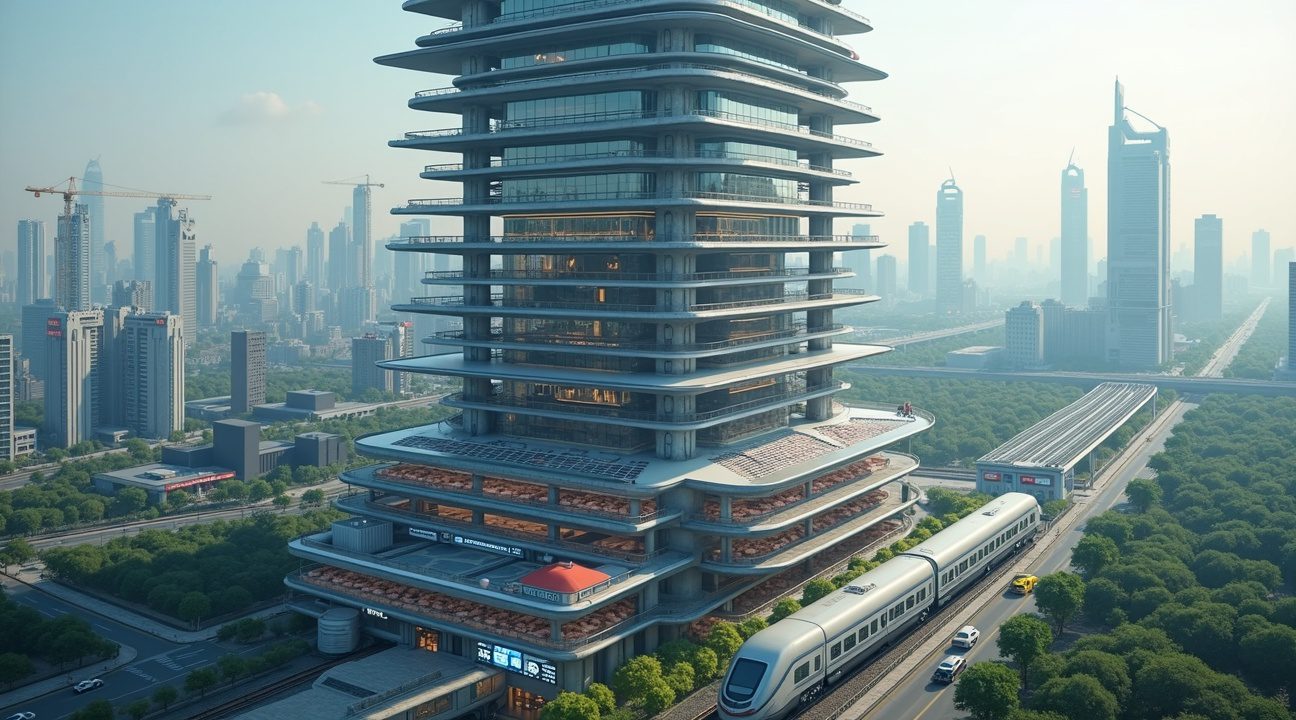China’s cutting-edge 26-storey pig farm in Hubei Province marks a transformative shift in agricultural production, showcasing how vertical farming can meet the demands of food security, land scarcity, and biosecurity through scalable innovation.
Key Takeaways
- Massive Production Scale: The facility supports 1.2 million pigs annually across 26 vertically integrated floors. It yields approximately $200 million in yearly revenue and produces 108,000 tonnes of pork, with over 800 employees overseeing operations.
- Advanced Automation Systems: The structure features fully automated systems that manage feeding, watering, waste disposal, and climate regulation through 30,000 control points. These systems enhance labor efficiency, enabling a single worker to manage up to 1,500 pigs—far surpassing the 200–300 pig capacity of traditional farms.
- Superior Biosecurity Protection: Each floor functions as a self-contained unit with independent air circulation systems. This design minimizes the risk of disease transmission between levels and offers strong defense against epidemics such as African Swine Fever that previously affected China’s pig population.
- Environmental Innovation: The facility incorporates biogas waste-to-energy systems that cut odorous emissions by more than 90%. Pig manure is converted into renewable energy, and waste heat is recovered in partnership with nearby cement plants, further reducing environmental impact.
- Land Efficiency Solution: Utilizing a vertical design, the farm achieves the pork output typically requiring hundreds of acres, which is particularly valuable in a country like China where arable land is limited.
To explore more about this extraordinary development, you can read further via this Reuters article on China’s 26-storey pig skyscraper.
Inside the World’s Largest Single-Building Pig Farm That Produces 1.2 Million Pigs Annually
I find myself fascinated by what might be the most extraordinary agricultural facility ever constructed. In Ezhou, Hubei Province, two towering 26-storey skyscrapers rise from the landscape, but these aren’t office buildings or residential complexes. They house what’s arguably the world’s largest single-building pig farm, a facility that redefines how we think about livestock production.
The Scale and Investment Behind This Agricultural Skyscraper
Hubei Zhongxin Kaiwei Modern Husbandry invested approximately $570 million (4 billion RMB) to create this vertical farming marvel. The facility spans an estimated floor area between 400,000 to 800,000 square meters across both towers. This investment represents a significant shift in agricultural thinking, much like how e-commerce has transformed traditional retail models.
The numbers behind this operation are staggering. With its current capacity, the farm raises and slaughters 1.2 million pigs annually, producing around 108,000 tonnes of pork. At prevailing market prices, this translates to an estimated $200 million in pork sales each year. Operations commenced in late 2022, and the facility provides employment to over 800 workers who manage this complex vertical ecosystem.
Operational Excellence in Vertical Agriculture
I’m struck by how this facility challenges conventional farming wisdom. Traditional pig farming spreads across vast horizontal spaces, but this approach concentrates everything into a vertical structure that maximizes land efficiency. Each floor operates as a controlled environment where temperature, humidity, and air quality are precisely managed.
The facility’s design addresses several critical challenges facing modern agriculture. Land scarcity, environmental concerns, and the need for biosecurity have driven innovations that might seem more suited to autonomous vehicle development than farming. Advanced ventilation systems ensure air quality throughout all 26 floors, while automated feeding and waste management systems streamline operations.
What sets this operation apart isn’t just its height but its integration of technology with traditional animal husbandry. The facility employs sophisticated monitoring systems that track animal health, growth rates, and environmental conditions in real-time. This level of oversight allows managers to optimize production while maintaining animal welfare standards across every floor.
The environmental implications are equally significant. By concentrating production vertically, the farm reduces its land footprint dramatically compared to traditional operations of similar scale. Waste management systems process byproducts efficiently, potentially reducing environmental impact per unit of production.
Economic efficiency drives every aspect of this operation. The facility’s ability to generate $200 million annually from a relatively compact footprint demonstrates how vertical farming can maximize returns on investment. This approach might inspire similar developments in regions where land costs make traditional farming economically challenging.
The employment opportunities created by this facility extend beyond typical farm work. Workers require specialized skills to manage automated systems, monitor environmental controls, and maintain sophisticated equipment. This creates a new category of agricultural jobs that blend traditional animal husbandry with modern technology management.
China’s commitment to food security and agricultural innovation finds clear expression in this project. The facility represents a response to growing protein demand while addressing land use efficiency and environmental sustainability concerns. Similar to how innovative approaches to saving money challenge conventional wisdom, this vertical farm challenges traditional agricultural methods.
The success of this 26-storey pig farm in Ezhou will likely influence future agricultural development decisions across China and potentially worldwide. As land becomes increasingly scarce and valuable, vertical farming solutions may become essential for meeting global protein demands while maintaining environmental responsibility.
https://www.youtube.com/watch?v=27I5uX-sWjE
Revolutionary Automation Technology Transforms Pig Farming Operations
I find the automation systems within this towering facility nothing short of extraordinary. The farm operates through fully automated networks that handle feeding, watering, waste management, and climate control across all 26 floors. A central control room serves as the nerve center, monitoring over 30,000 control points in real-time to ensure optimal conditions throughout the entire structure.
Each floor functions as an independent farm unit, featuring isolated air systems that prevent disease transmission between levels. This design creates multiple biosecurity barriers, significantly reducing the risk of widespread contamination that could devastate traditional single-level operations. The isolation technology ensures that if one floor experiences health issues, the remaining 25 floors continue operating without interruption.
Advanced Infrastructure and Operational Efficiency
The facility incorporates specialized pig elevators capable of transporting up to 40 tonnes, enabling seamless relocation of sows and piglets across different floors. These elevators revolutionize how farmers manage livestock movement, eliminating the stress and labor associated with traditional animal transport methods. I observe that this innovation allows for precise placement of animals based on their development stage and specific care requirements.
The operational workflow follows a structured lifecycle approach with designated zones for each phase:
- Gestation areas where sows spend their pregnancy period
- Farrowing sections for birthing and early piglet care
- Nursery floors for weaning and early development
- Growing areas where pigs reach market size
Pigs typically spend 6 to 8 months within the facility before reaching market weight, moving through these specialized zones as they mature. This systematic approach optimizes space utilization while ensuring each animal receives appropriate care based on its developmental needs.
Labor efficiency reaches remarkable levels through smart farming technology integration. A single worker can effectively manage up to 1,500 pigs, compared to traditional farms where one person typically handles 200-300 animals. This dramatic improvement stems from automated feeding systems, real-time health monitoring, and centralized environmental controls that reduce manual intervention requirements.
The central control system provides continuous oversight of temperature, humidity, air quality, and feed distribution across all floors. Sensors throughout the building collect data on animal behavior, growth rates, and environmental conditions, feeding information back to the control room where operators can make immediate adjustments. This level of monitoring ensures optimal growing conditions while minimizing resource waste and maximizing production efficiency. Much like how commerce continues evolving, agricultural technology pushes boundaries through innovative automation solutions.
Advanced Biosecurity Measures Address China’s Food Security Crisis
China’s towering 26-story pig facility in Hubei province represents a revolutionary response to the country’s pressing food security challenges. The facility implements stringent biosecurity protocols that fundamentally reshape how livestock operations can protect against disease outbreaks while maintaining massive production capacity.
Comprehensive Disease Prevention Protocols
All personnel entering the facility must undergo rigorous disinfection procedures before accessing any production floor. Staff members typically limit their departures from the site to once weekly, creating a controlled environment that minimizes external contamination risks. This approach reflects lessons learned from devastating disease outbreaks that have plagued China’s pork industry in recent years.
The country’s experience with African Swine Fever between 2018 and 2020 demonstrates why such extreme measures are necessary. During this period, China lost up to 100 million pigs, creating significant disruptions in both domestic supply chains and global pork markets. The outbreak highlighted vulnerabilities in traditional farming methods and accelerated the development of innovative agricultural technologies that could prevent similar catastrophes.
Meeting Escalating Demand Through Controlled Production
China consumes approximately 50% of the world’s pork supply, making domestic production security a national priority. Projected pork demand is expected to surge from 51.77 to 60.77 million tonnes annually over the next decade, creating enormous pressure on producers to scale operations efficiently.
The Hubei facility addresses this challenge through carefully planned expansion phases. Operations began with an initial stocking of 3,700 sows, establishing baseline production capabilities while testing biosecurity systems. Plans call for expanding to over 20,000 breeding pigs, with the introduction of 21,600 sows and 55 boars for full-scale operation.
This controlled breeding approach allows operators to maintain genetic diversity while maximizing production efficiency. The vertical structure enables precise environmental controls that traditional farms cannot achieve, from temperature regulation to waste management systems. Each floor can operate as an independent production unit, reducing cross-contamination risks while maintaining optimal conditions for different growth stages.
The facility’s design philosophy extends beyond simple disease prevention. Advanced ventilation systems ensure air quality remains consistent throughout all levels, while automated feeding systems reduce human contact with animals. These measures create multiple barriers against disease transmission while supporting the growing demand for efficient protein production.
Modern sensors monitor animal health continuously, enabling early detection of potential issues before they spread throughout the facility. This real-time monitoring capability represents a significant advancement over traditional farming methods, where disease detection often occurs too late to prevent widespread losses.
The economic implications of this approach are substantial. With annual revenue projections of $200 million and capacity for 1.2 million pigs, the facility demonstrates how vertical farming concepts can apply to livestock production. This model could influence market dynamics across the agricultural sector, particularly as other countries face similar food security pressures.
Success at this scale requires unprecedented coordination between veterinary teams, facility managers, and production staff. Each group must understand their role in maintaining the biosecurity envelope that protects the entire operation. Training programs ensure consistency in protocol execution, while regular audits verify that standards remain effective against emerging threats.
The facility represents more than technological innovation; it embodies China’s strategic approach to achieving food independence in an increasingly uncertain global environment. By concentrating production in highly controlled environments, operators can achieve predictable output levels while minimizing exposure to external shocks that have historically disrupted traditional farming operations.
https://www.youtube.com/watch?v=WmhUAqw_bcI
Environmental Innovation Through Waste-to-Energy Systems
The 26-story pig facility in Hubei represents a groundbreaking approach to agricultural waste management through its comprehensive biogas-based treatment systems. These sophisticated systems transform pig manure into clean energy that powers both electricity generation and heating throughout the massive structure. The innovative design addresses one of livestock farming’s most persistent challenges while creating valuable energy resources.
Biogas technology captures methane emissions from decomposing organic waste and converts them into usable energy. The farm’s implementation of this technology demonstrates how industrial innovations can address environmental concerns while maintaining profitability. The process significantly reduces the farm’s carbon footprint by preventing methane from escaping into the atmosphere and simultaneously generating power for operations.
Circular Economy Benefits and Land Efficiency
The environmental advantages extend beyond energy production through strategic partnerships with nearby industrial facilities. The farm’s proximity to a cement plant creates additional opportunities for waste heat recovery. This collaboration allows the facility to repurpose excess thermal energy from cement production to meet heating demands, further reducing energy consumption and operational costs.
Several key environmental benefits emerge from this integrated approach:
- Odorous gas emissions decrease by over 90% compared to traditional pig farming methods
- Biogas systems prevent methane release while generating renewable energy
- Waste heat recovery from the cement plant reduces overall energy demands
- Vertical design minimizes land use impact in densely populated areas
- Closed-loop systems reduce water consumption and waste discharge
The high-rise design addresses China’s critical land use challenges by maximizing production capacity within a minimal footprint. Traditional pig farming requires extensive horizontal space, but this vertical approach allows the same production volume on significantly less land. This efficiency becomes crucial in regions where agricultural land competes with urban development and industrial expansion.
The facility’s waste-to-energy systems process approximately 1,200 tons of manure daily, converting this organic waste into valuable resources rather than environmental liabilities. The biogas production provides enough energy to power significant portions of the farm’s operations, including ventilation systems, feeding mechanisms, and climate control throughout all 26 floors.
Temperature regulation becomes especially important in such a massive vertical structure. The combination of biogas heating and recovered cement plant heat creates a sustainable thermal management system that maintains optimal conditions for pig health and growth. This integrated approach reduces reliance on external energy sources while minimizing environmental impact.
The waste treatment systems also include water purification processes that clean wastewater before discharge. Advanced filtration and biological treatment methods ensure that water leaving the facility meets environmental standards. These systems prevent contamination of local water sources while reducing the farm’s overall environmental footprint.
Smart monitoring systems track energy production and consumption throughout the facility, optimizing efficiency and identifying opportunities for improvement. Real-time data collection allows operators to adjust biogas production rates, manage waste heat recovery, and maintain optimal environmental conditions. This technological integration ensures maximum environmental benefit while maintaining production targets.
The success of this environmental innovation model demonstrates potential for replication across China’s agricultural sector. The technology proves that large-scale livestock operations can achieve environmental sustainability while maintaining economic viability. The 90% reduction in odorous emissions alone represents a significant improvement in air quality for surrounding communities.
Resource recovery extends beyond energy generation to include nutrient recapture from processed waste. The remaining organic matter after biogas production creates valuable fertilizer that can support local agricultural activities. This circular approach transforms waste streams into revenue opportunities while supporting cost-effective operations.
The facility’s environmental innovations position it as a model for sustainable agriculture in developing economies. The combination of vertical farming, waste-to-energy systems, and industrial heat recovery creates a comprehensive solution for modern agricultural challenges. This approach balances production demands with environmental responsibility, demonstrating that intensive farming can coexist with sustainability goals.

How Vertical Farming Outperforms Traditional Pig Operations
China’s innovative 26-storey pig farm in Hubei represents a fundamental shift from conventional agriculture practices. Traditional pig farms spread across hundreds of acres, consuming vast amounts of valuable land that could serve alternative purposes. I’ve observed how this vertical approach transforms that model by stacking production levels within a single building footprint, dramatically reducing the land requirements for equivalent output.
Biosecurity and Labor Efficiency Advantages
The vertical design creates distinct advantages in disease prevention that traditional farms simply can’t match. Each floor operates as an isolated unit, preventing cross-contamination between different pig populations. Traditional farms often struggle with disease outbreaks that can spread rapidly across open facilities, resulting in significant financial losses and animal welfare concerns.
Labor productivity reaches remarkable levels in this vertical system, with specific metrics highlighting the efficiency gains:
- One worker manages up to 1,500 pigs in the vertical facility
- Traditional farms typically require one worker per 300–500 pigs
- Automated feeding and monitoring systems reduce manual intervention
- Centralized management systems allow real-time health monitoring across all floors
- Reduced travel time between production areas increases worker efficiency
Production Scale and Environmental Management
The production capacity differences are striking when comparing vertical operations to conventional methods. Traditional pig farms typically produce thousands to tens of thousands of animals annually, requiring multiple facilities to achieve significant scale. This vertical facility processes 1.2 million pigs per year within a single structure, demonstrating unprecedented efficiency in livestock production.
Environmental stewardship takes on new dimensions in vertical farming systems. Traditional operations often struggle with waste management, odor control, and environmental impact across large geographical areas. The Hubei facility integrates biogas-based waste processing systems that convert organic waste into renewable energy. These systems include sophisticated odor control mechanisms that address one of the most significant challenges facing traditional pig farming operations.
Automation plays a crucial role in maintaining consistent environmental conditions throughout the facility. Climate control systems regulate temperature, humidity, and air quality on each floor independently. Traditional farms rely on natural ventilation and basic heating systems that can’t provide the same level of precision or consistency.
The concentrated nature of vertical farming allows for more sophisticated monitoring and management systems. Sensors throughout the facility track air quality, temperature fluctuations, and animal behavior patterns. Digital platforms enable farm managers to access real-time data and make immediate adjustments to optimize conditions.
Water usage efficiency also improves significantly in vertical systems. Traditional farms often waste water through inefficient distribution systems and runoff. The vertical facility captures and recycles water throughout the system, reducing overall consumption and environmental impact.
Sustainability extends beyond immediate operational benefits. The reduced land footprint preserves agricultural space for crop production or natural habitat preservation. Cost savings from improved efficiency translate into more competitive pricing while maintaining profitability.
Feed distribution systems in vertical farms eliminate the transportation costs and time associated with servicing multiple traditional facilities spread across large areas. Centralized feed storage and automated distribution systems ensure consistent nutrition delivery while reducing labor requirements and feed waste.
The integration of renewable energy sources, particularly biogas generation from waste products, creates a more self-sufficient operation. Traditional farms typically rely entirely on external energy sources, making them vulnerable to price fluctuations and supply disruptions. The vertical system’s energy independence contributes to long-term operational stability and reduced environmental impact.
Quality control measures benefit from the controlled environment and systematic approach of vertical farming. Traditional operations face challenges in maintaining consistent conditions across large, open areas subject to weather variations and external factors. The enclosed, controlled environment enables precise management of all production variables.
https://www.youtube.com/watch?v=QX9breRZTFo

The Future of Industrial Agriculture in China’s Growing Economy
China’s revolutionary 26-story pig facility represents a significant shift in how agricultural production adapts to modern challenges. This vertical farming approach emerged as a direct response to the devastating African Swine Fever outbreak that decimated the country’s pig population, forcing agricultural leaders to rethink traditional farming methods. I see this massive investment as a clear signal that China views biosecure, technologically advanced facilities as essential for protecting food security.
Addressing Critical Land Constraints Through Innovation
The vertical design tackles one of China’s most pressing agricultural challenges: limited arable land in densely populated regions. Traditional pig farming requires extensive horizontal space, but this tower model maximizes production capacity within a minimal footprint. China’s government has shown unwavering commitment to agricultural modernization through technology, and this facility serves as a prime example of that dedication. The project demonstrates how innovative thinking can transform space limitations into opportunities for enhanced productivity, similar to how e-commerce growth has revolutionized retail spaces.
Scalability and Economic Potential
The facility’s design offers promising applications beyond pig farming, potentially extending to other livestock operations and agricultural ventures. I believe this scalable model could reshape how China approaches food production across multiple sectors. The substantial $570 million investment reflects strong confidence in vertical farming’s long-term economic viability and potential returns.
This project generates impressive financial results, producing approximately $200 million annually from its 1.2 million pig capacity. Such figures validate the economic sustainability of industrial agriculture modernization efforts. The success metrics suggest that similar facilities could become cornerstones of China’s agricultural strategy, addressing both food security concerns and economic growth objectives.
The biosecure environment created within this vertical structure provides protection against disease outbreaks that have historically devastated traditional farming operations. Advanced climate control systems and automated feeding mechanisms reduce human contact while maintaining optimal conditions for livestock health and growth. These technological integrations position China at the forefront of agricultural innovation, much like how autonomous vehicle technology is transforming transportation sectors.
This facility represents more than just efficient pig production; it showcases China’s broader agricultural transformation strategy. The vertical farming benefits extend beyond space efficiency to include:
- Enhanced disease prevention
- Improved environmental controls
- Reduced resource consumption per unit of production
As China continues expanding its agricultural modernization efforts, similar projects will likely emerge across different provinces and livestock categories.

Sources:
Hubei Zhongxin Kaiwei Modern Husbandry


